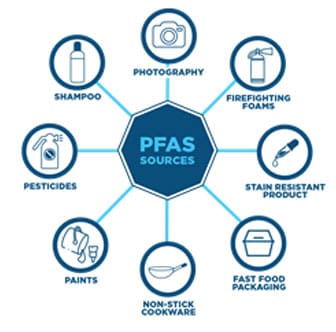
Table of Contents
There is a group of artificially-made chemicals that include PFOA, PFOS, and GenX. Among many others, PFAS or per- and polyfluoroalkyl substances are manufactured and utilized in various industries worldwide.
It is the by-product created by combining fluorine and carbon. It is considered one of the strongest bonds in organic chemistry. It results in a substance that enables everyday items to become resistant to heat, stains, and moisture.
Among the commonly used PFAS chemicals are perfluorooctanesulfonic (PFOS) and perfluorooctanoic acid. These chemicals possess long half-lives, granting them the term “the forever chemical.“
As a result, certain PFAS chemicals have been regulated and are not permitted to be manufactured in the United States. However, PFOS and PFOA are still manufactured internationally. Here are some of the most important things that you need to know about PFAS.
What is PFAS?
Found in a large variety of consumer products that people use, such as pizza carton boxes, and cookware items, it is undeniable that PFAS is inseparable from our routines. Its water and fat repelling abilities enable the said chemical to be applied to almost any type of material.
First seen in the 1940s, the chemical has been used in clothing, carpet, paints, polishes, cleaning products, food packaging, waxes, and almost everything that requires the chemical’s water and oil repelling properties.
Considered as one of the widely produced and researched chemicals, PFAS can be found in a variety of outlets. According to the US EPA, it is a component in manufacturing food equipment, production facilities, commercial household products, drinking water, and living organisms.
PFOA and PFOS are both highly persistent in human physiology and the environment. In simpler terms, these chemicals do not break down, and additionally, they tend to accumulate gradually. Sufficient studies reveal that exposure to PFAS can contribute to adverse health effects.
Due to their properties, PFAS chemicals have become one of the most-interacted items used by people. It points to a hazard considering that multiple research studies reveal that this has led to widespread health and environmental contamination.
How Do You Get Exposed to PFAS?
Exposure to PFAS happens through contact with areas such as drinking water wells and public water systems. It is more prominent in sites near areas that involve PFAS production, disposal, and utilization.
PFAS can also be contacted through consumer products, groundwater receiving run-off from areas that concern usage of firefighting foam, and fish from contaminated bodies of water.
Its Risks to Unborn Babies and Young Children
Pregnant women are at risk of their unborn children getting exposed to chemicals through the umbilical cord during pregnancy. Other means of exposure would include breast milk or by using formula made with water that has been exposed to PFAS.
Young children tend to have a higher risk of exposure from cleaning products and carpets, considering their age bracket’s time spent on the floor in their early stages. Older children may also be exposed to water and food in general.
How Common Is It For People To Have PFAS In Their Blood?
Research studies display that exposure to PFAS has been widespread and concerning. People in the United States and industrialized countries have considerably measurable amounts of the chemical in their blood.
Researchers say that it is highly unlikely that a person possesses a “zero” level of PFAS in their system, even if they did not directly drink contaminated water or partake in food that has been exposed to it.
In the United States, the manufacturers of PFAS-related items have been regulated to phase out their production back in 2002. It also included their production of PFOA in the year 2013. However, this does not mean that PFAS manufacturing has been stopped completely. There are still some areas that manufacture the substance in smaller amounts in the country.
According to the Center for Disease Control and Prevention (CDC), the levels of PFOS and PFOA in the system of the general public have decreased steadily. The ongoing decrease was a result of phasing out the production.
However, the risks are still apparent considering that PFAS remains in the human physiology and environment for years even after first exposure.
Health Risks Correlated to PFAS Exposure
Found in blood at much lower levels in breast milk, urine, and in umbilical cord blood, PFAS tend to stay in overtime in the human body. And the following complications are said to be correlated with the prolonged exposure of this substance: risks of developmental effects in infants, infertility, interference with natural hormones, effects on the immune system, and risks of cancer.
Depending on multiple factors, the adverse health effects rely on the amount, the period of exposure, and the concentration of the PFAS being ingested/exposed to the individual or people.
Moreover, the toxicity and health effects of PFAS is currently still not well understood and definite. Moreover, there are still a lot of ongoing studies being performed by professionals to gain more understanding. However, the biggest concerns lean towards pregnant women and children.
What Should I Do If I’m Concerned About My Risk to PFAS?
Individuals that are suspecting or are concerned with their exposure to large levels of PFAS should seek medical attention from a doctor or to a family healthcare provider. The same attention should be given to people who are showing symptoms related to such exposure.
For pregnant women, sensitive prenatal care is advised to prevent any mishaps in their pregnancy. Inform your obstetrician ahead of time about your condition so additional caution can be applied to your situation.
What Steps Should I Take If I Detected PFAS In My Water?
The Rhode Island Department of Health has recommended its people to avoid boiling their water. Doing this will prevent the concentration of these chemicals. Aside from that, they have advised using bottled water since it has undergone testing and treatment against these chemicals.
If you have a garden and are concerned about the PFAS levels in your soil, you should water your seedlings and plants using a cleaner water source. Additionally, you should modify your gardening soil with sanitary compost.
Moreover, you can also increase the organic content in your soil to prevent PFAS contamination. Once you harvest your produce, you should also make sure to wash it thoroughly in clean water before eating or processing.
If you’re worried about PFAS, there is one solution that can help you eradicate your worries about it. Investing in a whole house water filter can do wonders for your drinking water at home. See more here https://www.aquaoxwaterfilters.com/whole-house-water-filter/.






